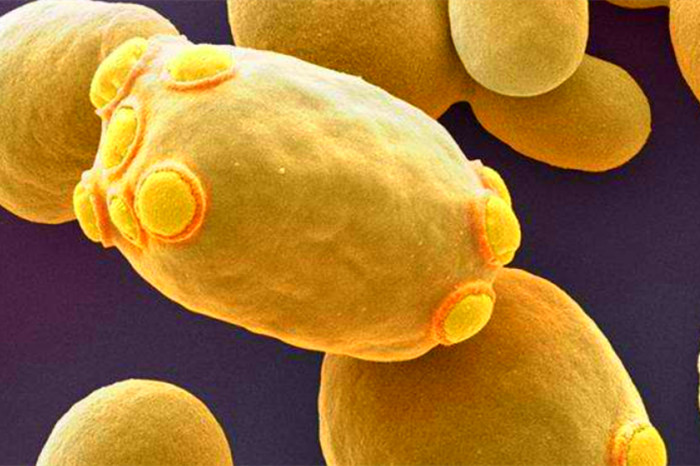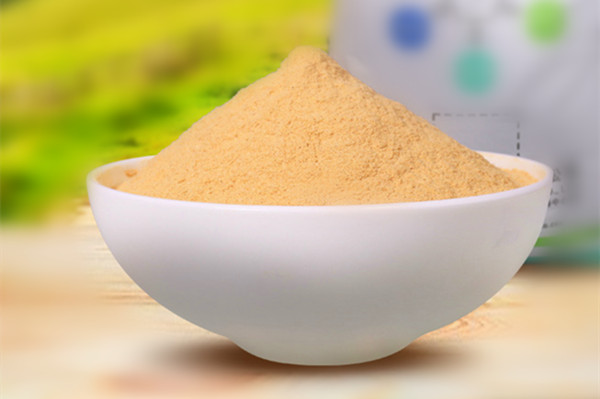Yeast is a single-celled eukaryotic microorganism, usually shaped of spherical, ovoid, oval, or condyle-shaped, or torose shape. Yeast often exists in carbohydrate-rich environments such as fruits (grapes, apples, peaches, etc.) or plant secretions (such as cactus juice), air, soil, water, and body of some animals. Yeasts can live with or without oxygen, and when oxygen is scarce, fermenting yeasts get energy by converting sugars into carbon dioxide and ethanol (commonly known as alcohol).
Yeast cell wall product is obtained by the yeast cell after autolysis, exogenous enzyme hydrolysis, mechanical crushing and other treatment, through centrifugation and finally concentration, drying and other processes, is light yellow or yellow-brown powder, no odor. The yeast cell wall is a kind of green additive, rich in β -glucan and mannan (MOS) and other biologically active substances, which can enhance immunity, promote growth, prevent and cure diseases, promote growth, relieve stress, absorb mycotoxins, supplement nutrition and other physiological functions. It has been applied to pig, poultry, ruminant livestock, aquaculture and other animal breeding due to its wide source and low cost.
Studies have shown that yeast cell walls can stimulate the immune function and disease resistance of animals, and participate in the release of TNF-α and other cytokines such as 1L-1, 1L-2 and 1L-6. Its function mainly depends on the credit to β -glucan and mannan.
The Effect Of Yeast Cell Wall
β -glucan
β -glucan of the yeast cell wall has an immunomodulatory function, which is related to its unique three-strand helix structure. There are some hydrophilic groups on the outer side of the helix, which are non-specific immune-stimulating polysaccharides, which can bind to the immune cell receptor specificity of the body, stimulate B cells, T cells, natural killer cells to produce a large number of macrophages, and then regulate the body’s immunity. β -glucan performs physiological functions through macrophages:
- Strengthen the phagocytic function;
- Promote specific immune response through the antigen presentation function of macrophages.
- Activated macrophages can secrete a variety of biologically active substances, such as TNF-α, 1L-1, NO, reactive oxygen species and so on. Among them, 1L-1 and NO are important immune regulatory factors with antiviral, anti-bacterial and anti-tumor activities. TNF-α can improve the permeability of vascular epithelial cells, promote the aggregation of immune effector molecules and stimulate the release of other inflammatory cytokines.
The antioxidant activity of yeast β -glucan showed that it could inhibit the liposome peroxidation induced by OH and significantly reduce conjugated diene bond formation. Carboxymethylated β-1, 3-glucan also has the function of scavenging free radicals and has obvious antioxidant activity. After injection of carboxymethyl dextran into mice suffering from arthritis, the determination of carboxylic group content in plasma showed that the oxidation degree of mouse tissues was eased, which provided a new idea for the application of carboxymethyl dextran in the treatment of arthritis.
Other biological functions of β -glucan. Previous studies have shown that β-1, 3-glucan in the animal digestive tract is not absorbed, is insoluble, and does not produce viscosity. It can clean up the intestinal tract, remove free radicals, dissolve cholesterol, prevent hyperlipidemia and other functions, and also resist infection caused by filtering bacteria, fungi and viruses. In addition, β-1, 3-glucan is a low-calorie food additive that can significantly reduce blood glucose levels, control obesity, and prevent diabetes and cardiovascular disease.
Mannan
The functions of mannan to adsorb pathogens and modulate immunity are well established. The key of intestinal pathogen infection is successful adhesion to intestinal mucosa. Exogenous lectins on the flagella or villi of pathogenic bacteria can specifically recognize and bind to the receptor of host epithelial cell membrane. Mannan exerts antibacterial function mainly through the following two aspects:
One is that it interferes with the colonization of intestinal pathogens. Principle: The specific receptors of pathogenic bacteria on the intestinal wall are particularly similar to the structure of mannose. If there is abundant mannose source in the intestinal wall, it can combine with the specific receptors of pathogenic bacteria to prevent pathogenic bacteria from attaching to the intestinal wall, so as to effectively inhibit infection. After combining with mannan, pathogenic bacteria cannot use mannan as the energy source for their growth, so mannan has the dual function of preventing the colonization and reproduction of pathogenic bacteria, so it is also called “pathogenic bacteria adsorbent” or “pathogenic bacteria scavenger”.
Second, mannan can be used as a nutrient for beneficial bacteria (such as bifidobacterium and lactobacillus) in the intestinal tract, which can promote the proliferation of beneficial bacteria and further inhibit the growth of harmful bacteria. Studies have shown that beer yeast mannan can promote the growth of beneficial bacteria and increase the content of volatile fatty acids in intestinal tract.
The immunomodulatory function of mannan is mainly exist in enhancing cytokine release and interferon activity, promoting or coordinating the activities of different immune cells, enhancing the migration of white blood cells to infection sites and activating macrophages. It was found that mannan supplementation in the diet of weaned piglets infected with PORcine reproductive and respiratory syndrome virus can significantly reduce serum TNF-α content, increase IL-1 content and lymphocyte number, thus ensuring the health of piglets
Mannan can also activate the immune response, and when used together with vaccines, it can combine with some viruses, toxins and eukaryotic cells. The combined mannan can be used as an exogenous antigen adjuvant, which can alleviate antigen absorption and improve antigen titer. Therefore, mannan can be used as an adjuvant to improve cellular humoral immunity of the body. In addition, mannan can firmly adsorb a variety of mycotoxins through hydrogen bonds and van der Waals forces and other molecular interactions to form polysaccharide toxin complexes and prevent toxins from being absorbed by the intestine. Its special spatial structure also provides more sites for toxin binding.
Energy effect
Glucan and mannan can be fermented and utilized by intestinal bacteria such as bifidobacterium to produce short-chain fatty acids in large intestine. Some short-chain fatty acids are utilized and converted into energy by intestinal mucosal epithelial cells, while the other part is transferred to the liver for utilization. The above functions can also increase the content of organic acids, reduce the production of decaying substances, ammonia and hydrogen sulfide emissions.
- Dandelion Extract: What It Is, Benefits, Uses and Side Effect - April 23, 2024
- Is Berberine Extract Help For Weight Loss? - April 11, 2024
- Why Is Pysllium Husk Powder A Popular Meal Replacement Ingredient? - April 3, 2024




